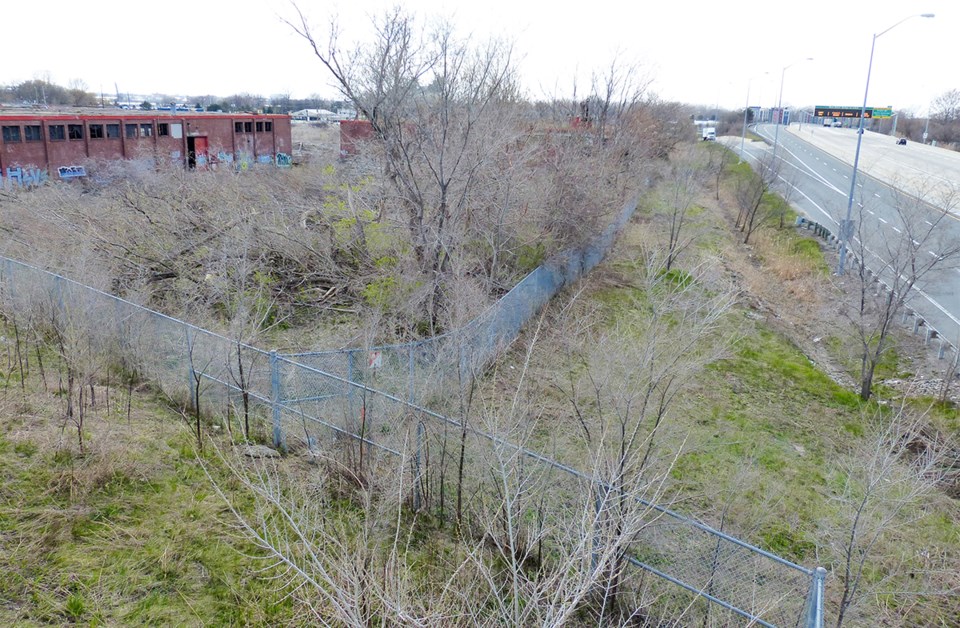Tom St. Amand
The land wedged between the abandoned Holmes Foundry buildings and Highway 402 is currently being cleared of trees and scrub for future development.
But nearly a century ago a street, known as Berkley Row, bisected it.

History might have completely bypassed Berkley Row if not for the controversial race riot of March 1937, and the national headlines it made.
Named after the foundry’s first superintendent, Berkley Row was a short street that angled 100 metres north on the Christina Street side of the factory, then veered 120 metres straight west along its north wall.
Holmes Foundry was established in 1918, and management developed Berkley Row in the 1920s with housing on the north side, providing accommodation to the men building its engine blocks.
By 1937, about 20 small houses stood on the east-west section of Berkley Row, separated from the factory by a tall chain link fence.
These home were initially tarpaper shacks without hydro or running water, and eventually replaced with small bungalows featuring standard conveniences of the time.
But if the houses on Berkley Row changed over the years, the residents occupying them did not: poor European immigrants, typically Slovaks, Poles, and Italians, labouring to support themselves and their families.
Job conditions were harsh. With little ventilation, the men finished shifts covered in dust, but weren’t provided with showers. And with no lunch area, they ate meals in the same room as makeshift and unsanitary toilet facilities.
By 1937 the European immigrants had had enough. They presented management with a set of demands: an eight-hour shift, a daily wage of $5, showers, toilets and a lunchroom, and recognition of their union committee.
When superintendent W. B. Millholland refused to negotiate, 30 to 50 workers laid down their tools on March 1. All production ceased and Holmes Foundry became the site of the second wildcat strike in Canada's history.
Emotions were running high when, two days later, 300 Canadian-born men armed with blackjacks and bullwhips gathered outside the foundry and demanded the strikers step out. Racial tensions that had already existed between the immigrants and Canadian-born workers erupted on the morning of March 3.
When some strikebreakers attempted to access the foundry, determined strikers met them on the roof. A pitched battle broke out and the strikers were soon overwhelmed. One man tried to escape but fell 30 feet to the ground and fractured his spine, pelvis, and ankle.
The strikebreakers then used a truck to break down a door, rushed in and dragged strikers outside.
Some who fled to their homes were followed.
Maria Koval (nee Hudak), then age 12, recounted years later how an unknown striker ran into her family's modest home on Water Street and hid under a bed. Shortly after, strikebreakers burst in, found the man, hauled him into the street, and beat him with their clubs.
Homes on Berkley Row were looted, and six men managed to escape by hiding in a departing milk truck.
Fifty men were injured in the riot, most superficially. Several strikers were hospitalized with serious injuries.
Not surprisingly, given the era, the strikers were found guilty of trespassing and received suspended sentences. At their trial, Magistrate Woodrow told the accused they were “more foolish—stupid if you like—than criminal.”
The April edition of the Canadian Forum observed, “The time will come when Sarnia and Ontario and all Canada will remember what happened . . . and be ashamed of it. But that time is not yet.”
In 1939, Berkley Row was renamed Athletic Park Row, a name it kept until 1950 when it became Berkley Row again.
The short, historic road was demolished in the 1950s, three decades before Holmes Foundry closed its doors for good in 1988.
Tom St. Amand is a retired high school teacher, regular contributor and The Journal’s quizmaster.
